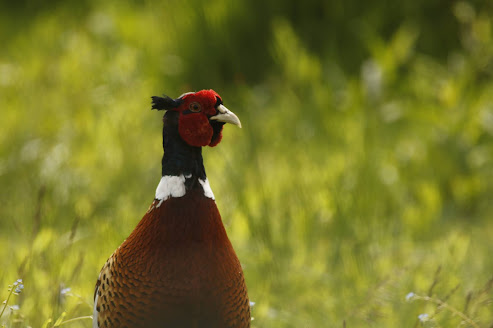Further down the Northumberland coast are a series of lowland wetlands set back from the sea. Based around old opencast mines that have been left to become overgrown by nature, which has resulted in them mainly becoming large lakes, they make for good birdwatching country. Managed by the Northumberland Wildlife Trust under whose guise they have been carefully managed for wildlife, these reserves are a haven for birds. Connected to each other by a ramble down the coast, they are accessed along the long distance footpath which snakes its way from reserve to reserve . These are quite important Northumberland reserves and I've been wanting to see these them for a while and now I finally got the chance.
Hauxley
The first reserve I visited was Hauxley, the most northerly of the reserves. Its a focal point for the area, with toilets and a café providing civilised amenities absent from a lot of nature reserves. The reserve consists of a large lake surrounded by hides with a small amount of peripheral land. The lake had a variety of islands and were a haven for birds.
The most obvious birds were the GEESE with hundreds present, these birds have increased to almost plague like numbers and at a lot of places are out numbering and out muscling all the other birds. DUCK wise there were also some TUFTED DUCK, GADWALL and a pair of SHOVELLER present, the usual birds of this kind of habitat at this time of year. There were some roosting GULLS and TERNS, but nothing special.
Probably the most sought after bird on the reserve was the TREE SPARROW. This is one of those birds which used to be extremely common right across the country, but whose population crashed due to the increased industrialisation of agriculture in the countryside. Nowadays there's only a couple of pairs in Suffolk, so they are difficult to find at the best of times. They are similar to house sparrows, but are birds of the countryside and are seldom seen in areas of human habitation. At Hauxley they were seen from a special hide, over looking some bird feeders which attracted a flock of the birds. Strangely enough the viewpoint was called the Skua Hide, the least appropriate name for a hide possible, really. Also around the reserve it was good hearing a WILLOW WARBLER, a once common bird that has become extinct on the Suffolk coast, although its still common up north.
From Hauxley it was a walk to the dunes and from there I wondered down the coast to the next reserve. There was plenty of nice, easy walking available, either walking the long distance footpath, or simply walking long the beach.
East Chevington
This reserve was a huge lake formed from opencast mining, with a reed periphery. Being June not much was present, because at this time of year the birds are in low densities as they nest. It is in winter when the birds all join together, creating large flocks so a visit then is probably the best time to visit. Present today was the same sort of birds as Hauxley, a few DUCKS, some GEESE, although not as in high numbers.
A second, smaller pool, held a large stand of reeds where a female MARSH HARRIER was quartering. Speaking to local bird watchers, they were really chuffed to have harriers nesting here, with five pairs present. Me, being from Suffolk, am much more blasé.
Walking down the coast along the coastal footpath from East Chevington, the path travelled down a large stretch of dunes. This large amount of rough grassland was really good for birds. Three pairs of STONECHAT were present along this route, as well as large numbers of MEADOW PIPITS and SKYARKS, often in song and display flight. A common flower in the dunes was the beautiful BLOODY CRANESBILL, a deep red flower low growing in the rough grassland. At one point a MED GULL flew over, giving a nice record.
Druridge Pools
The final reserve I visited today, although there is another one further down the road, was Druridge Pools. At Druridge a hide overlooks a pool in some wet meadowland, and another a former opencast lake. The wet meadowland pool had a variety of breeding waders, with some young AVOCETS present. Two ROE DEER were frolicking in the higher land behind. The lake held the usual wildfowl.
A nice exploration of some Northumberland wetlands, a bit different to the bird cliffs further up the coast. These are probably the best area of freshwater wetlands in the county, and although I visited at the wrong season I still saw some good birds. Such is the variety of decent bird watching sites in the county, you can make several visits to Northumberland and still spend your time exploring new areas .








No comments:
Post a Comment